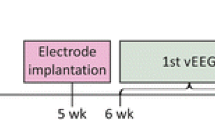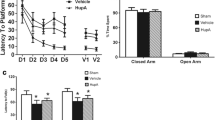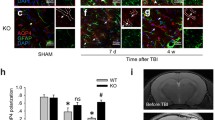Abstract
We previously demonstrated the increased amyloid precursor protein (APP) immunoreactivity around the site of damage after traumatic brain injury (TBI). However, the function of APP after TBI has not been evaluated. In this study, we investigated the effects of direct infusion of an anti-APP antibody into the damaged brain region on cerebral function and morphological changes following TBI in rats. Three days after TBI, there were many TUNEL-positive neurons and astrocytes around the damaged region and a significantly greater number of TUNEL-positive cells in the PBS group compared with the anti-APP group found. Seven days after TBI, there were significantly a greater number of large glial fibrillary acidic protein-positive cells, long elongated projections, and microtubule-associated protein-2-positive cells around the damaged region in the anti-APP group compared with the PBS group found. Seven days after TBI, the region of brain damage was significantly smaller and the time to arrival at a platform was significantly shorter in the anti-APP group compared with the PBS group. Furthermore, after TBI in the anti-APP group, the time to arrival at the platform recovered to that observed in uninjured sham operation group rats. These data suggest that the overproduction of APP after TBI inhibits astrocyte activity and reduces neural cell survival around the damaged brain region, which speculatively may be related to the induction of Alzheimer disease-type dementia after TBI.





Similar content being viewed by others
References
Goldgaber D, Lerman MI, McBride OW et al (1987) Characterization and chromosomal localization of a cDNA encoding brain amyloid of Alzheimer’s disease. Science 235:877–880. doi:10.1126/science.3810169
Robakis NK, Ramakrishna N, Wolfe G et al (1987) Molecular cloning and characterization of a cDNA encoding the cerebrovascular and the neuritic plaque amyloid peptides. Proc Natl Acad Sci U S A 84:4190–4194. doi:10.1073/pnas.84.12.4190
Masters CL, Multhaup G, Simms G et al (1985) Neuronal origin of a cerebral amyloid: neurofibrillary tangles of Alzheimer’s disease contain the same protein as the amyloid of plaque cores and blood vessels. EMBO J 4:2757–2763
Selkoe DJ, Abraham CR, Podlisny MB et al (1986) Isolation of low-molecular-weight proteins from amyloid plaque fibers in Alzheimer’s disease. J Neurochem 46:1820–1834
Golde TE, Estus S, Younkin LH et al (1992) Processing of the amyloid protein precursor to potentially amyloidogenic derivatives. Science 255:728–730. doi:10.1126/science.1738847
Murakami N, Yamaki T, Iwamoto Y et al (1998) Experimental brain injury induces expression of amyloid precursor protein, which may be related to neuronal loss in the hippocampus. J Neurotrauma 15:993–1003
Stephenson DT, Rash K, Clemens JA (1992) Amyloid precursor protein accumulates in regions of neurodegeneration following focal cerebral ischemia in the rat. Brain Res 593:128–135. doi:10.1016/0006-8993(92)91274-I
Otsuka N, Tomonaga M, Ikeda K (1991) Rapid appearance of beta-amyloid precursor protein immunoreactivity in damaged axons and reactive glial cells in rat brain following needle stab injury. Brain Res 568:335–338. doi:10.1016/0006-8993(91)91422-W
Itoh T, Satou T, Nishida S et al (2009) Expression of amyloid precursor protein after rat traumatic brain injury. Neurol Res (in press)
Roberts GW, Allsop D, Bruton C (1990) The occult aftermath of boxing. J Neurol Neurosurg Psychiatry 53:373–378. doi:10.1136/jnnp.53.5.373
Schofield PW, Tang M, Marder K et al (1997) Alzheimer’s disease after remote head injury: an incidence study. J Neurol Neurosurg Psychiatry 62:119–124. doi:10.1136/jnnp.62.2.119
Nicoll JA, Roberts GW, Graham DI (1995) Apolipoprotein E epsilon 4 allele is associated with deposition of amyloid beta-protein following head injury. Nat Med 1:135–137. doi:10.1038/nm0295-135
Xiong Y, Mahmood A, Lu D et al (2008) Histological and functional outcomes after traumatic brain injury in mice null for the erythropoietin receptor in the central nervous system. Brain Res 1230:247–257. doi:10.1016/j.brainres.2008.06.127
Itoh T, Satou T, Hashimoto S et al (2005) Isolation of neural stem cells from damaged rat cerebral cortex after TBI. Neuroreport 16:1687–1691. doi:10.1097/01.wnr.0000183330.44112.ab
Itoh T, Satou T, Nishida S et al (2007) Immature and mature neurons coexist among glial scars after rat traumatic brain injury. Neurol Res 29:734–742. doi:10.1179/016164107X208086
Green-Sadan T, Kinor N, Roth-Deri I et al (2003) Transplantation of glial cell line-derived neurotrophic factor-expressing cells into the striatum and nucleus accumbens attenuates acquisition of cocaine self-administration in rats. Eur J Neurosci 18:2093–2098. doi:10.1046/j.1460-9568.2003.02943.x
Elvander E, Schott PA, Sandin J et al (2004) Intraseptal muscarinic ligands and galanin: influence on hippocampal acetylcholine and cognition. Neuroscience 126:541–557. doi:10.1016/j.neuroscience.2004.03.058
Roberts GW (1988) Immunocytochemistry of neurofibrillary tangles in dementia pugilistica and Alzheimer’s disease: evidence for common genesis. Lancet 2:1456–1458. doi:10.1016/S0140-6736(88)90934-8
Roberts GW, Gentleman SM, Lynch A et al (1994) Beta amyloid protein deposition in the brain after severe head injury: implications for the pathogenesis of Alzheimer’s disease. J Neurol Neurosurg Psychiatry 57:419–425. doi:10.1136/jnnp.57.4.419
Rumble B, Retallack R, Hilbich C et al (1989) Amyloid A4 protein and its precursor in Down’s syndrome and Alzheimer’s disease. N Engl J Med 320:1446–1452
Sun KH, Sun GH, Su Y et al (2004) Acidic-rich region of amyloid precursor protein induces glial cell apoptosis. Apoptosis 9:833–841. doi:10.1023/B:APPT.0000045793.44842.e7
Bouron A, Mbebi C, Loeffler JP et al (2004) The beta-amyloid precursor protein controls a store-operated Ca2+ entry in cortical neurons. Eur J Neurosci 20:2071–2078. doi:10.1111/j.1460-9568.2004.03680.x
Feng Z, Chang Y, Cheng Y et al (2004) Melatonin alleviates behavioral deficits associated with apoptosis and cholinergic system dysfunction in the APP 695 transgenic mouse model of Alzheimer’s disease. J Pineal Res 37:129–136. doi:10.1111/j.1600-079X.2004.00144.x
Gentleman SM, Nash MJ, Sweeting CJ et al (1993) Beta-amyloid precursor protein (beta APP) as a marker for axonal injury after head injury. Neurosci Lett 160:139–144. doi:10.1016/0304-3940(93)90398-5
Blumbergs PC, Scott G, Manavis J et al (1995) Topography of axonal injury as defined by amyloid precursor protein and the sector scoring method in mild and severe closed head injury. J Neurotrauma 12:565–572
Pierce JE, Trojanowski JQ, Graham DI et al (1996) Immunohistochemical characterization of alterations in the distribution of amyloid precursor proteins and beta-amyloid peptide after experimental brain injury in the rat. J Neurosci 16:1083–1090
Van den Heuvel C, Blumbergs PC, Finnie JW et al (1999) Upregulation of amyloid precursor protein messenger RNA in response to traumatic brain injury: an ovine head impact model. Exp Neurol 159:441–450. doi:10.1006/exnr.1999.7150
Chen XH, Siman R, Iwata A et al (2004) Long-term accumulation of amyloid-beta, beta-secretase, presenilin-1, and caspase-3 in damaged axons following brain trauma. Am J Pathol 165:357–371
Smith DH, Uryu K, Saatman KE et al (2003) Protein accumulation in traumatic brain injury. Neuromolecular Med 4:59–72. doi:10.1385/NMM:4:1-2:59
Ikonomovic MD, Uryu K, Abrahamson EE et al (2004) Alzheimer’s pathology in human temporal cortex surgically excised after severe brain injury. Exp Neurol 190:192–203. doi:10.1016/j.expneurol.2004.06.011
Blasko I, Beer R, Bigl M et al (2004) Experimental traumatic brain injury in rats stimulates the expression, production and activity of Alzheimer’s disease beta-secretase (BACE-1). J Neural Transm 111:523–536. doi:10.1007/s00702-003-0095-6
Stone JR, Okonkwo DO, Singleton RH et al (2002) Caspase-3-mediated cleavage of amyloid precursor protein and formation of amyloid Beta peptide in traumatic axonal injury. J Neurotrauma 19:601–614. doi:10.1089/089771502753754073
Van Den Heuvel C, Donkin JJ, Finnie JW et al (2004) Downregulation of amyloid precursor protein (APP) expression following post-traumatic cyclosporin-A administration. J Neurotrauma 21:1562–1572. doi:10.1089/0897715042441783
Hardy J (1997) Amyloid, the presenilins and Alzheimer’s disease. Trends Neurosci 20:154–159. doi:10.1016/S0166-2236(96)01030-2
Mattson MP, Cheng B, Culwell AR et al (1993) Evidence for excitoprotective and intraneuronal calcium-regulating roles for secreted forms of the beta-amyloid precursor protein. Neuron 10:243–254. doi:10.1016/0896-6273(93)90315-I
Thornton E, Vink R, Blumbergs PC et al (2006) Soluble amyloid precursor protein alpha reduces neuronal injury and improves functional outcome following diffuse traumatic brain injury in rats. Brain Res 1094:38–46. doi:10.1016/j.brainres.2006.03.107
Suh YH, Checler F (2002) Amyloid precursor protein, presenilins, and alpha-synuclein: molecular pathogenesis and pharmacological applications in Alzheimer’s disease. Pharmacol Rev 54:469–525. doi:10.1124/pr.54.3.469
Sola Vigo F, Kedikian G, Heredia L et al (2008) Amyloid-beta precursor protein mediates neuronal toxicity of amyloid beta through Go protein activation. Neurobiol Aging. doi:10.1016/j.neurobiolaging.2007.11.017
Matrone C, Di Luzio A, Meli G et al (2008) Activation of the amyloidogenic route by NGF deprivation induces apoptotic death in PC12 cells. J Alzheimers Dis 13:81–96
Mills J, Reiner PB (1999) Regulation of amyloid precursor protein cleavage. J Neurochem 72:443–460. doi:10.1046/j.1471-4159.1999.0720443.x
Nakagawa K, Kitazume S, Oka R et al (2006) Sialylation enhances the secretion of neurotoxic amyloid-beta peptides. J Neurochem 96:924–933. doi:10.1111/j.1471-4159.2005.03595.x
Jurynec MJ, Riley CP, Gupta DK et al (2003) TIGR is upregulated in the chronic glial scar in response to central nervous system injury and inhibits neurite outgrowth. Mol Cell Neurosci 23:69–80. doi:10.1016/S1044-7431(03)00019-8
Davies SJ, Goucher DR, Doller C et al (1999) Robust regeneration of adult sensory axons in degenerating white matter of the adult rat spinal cord. J Neurosci 19:5810–5822
Rudge JS, Silver J (1990) Inhibition of neurite outgrowth on astroglial scars in vitro. J Neurosci 10:3594–3603
Pekny M, Nilsson M (2005) Astrocyte activation and reactive gliosis. Glia 50:427–434. doi:10.1002/glia.20207
Bechmann I, Nitsch R (2000) Involvement of non-neuronal cells in entorhinal-hippocampal reorganization following lesions. Ann N Y Acad Sci 911:192–206
Deller T, Haas CA, Frotscher M (2000) Reorganization of the rat fascia dentata after a unilateral entorhinal cortex lesion. Role of the extracellular matrix. Ann N Y Acad Sci 911:207–220
Gallo V, Chittajallu R (2001) Neuroscience. Unwrapping glial cells from the synapse: what lies inside? Science 292:872–873. doi:10.1126/science.1060854
Silver IA, Deas J, Erecinska M (1997) Ion homeostasis in brain cells: differences in intracellular ion responses to energy limitation between cultured neurons and glial cells. Neuroscience 78:589–601. doi:10.1016/S0306-4522(96)00600-8
Acknowledgment
The authors thank Mari Machino and Emi Watanabe for technical assistance.
Author information
Authors and Affiliations
Corresponding author
Rights and permissions
About this article
Cite this article
Itoh, T., Satou, T., Nishida, S. et al. Improvement of cerebral function by anti-amyloid precursor protein antibody infusion after traumatic brain injury in rats. Mol Cell Biochem 324, 191–199 (2009). https://doi.org/10.1007/s11010-008-0013-1
Received:
Accepted:
Published:
Issue Date:
DOI: https://doi.org/10.1007/s11010-008-0013-1




